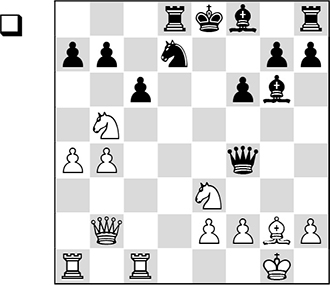Chapter 46
Eliminating defenders
Eliminating defenders is a tactical device by which enemy units, which defend his king or another important point, are removed from the board. Sometimes, such an elimination is part of a wider combination involving sacrifices. If the key defensive piece, which cements the defence, can be removed, the entire enemy position can collapse at once, like a house of cards.
277 *
Efim Geller
Oscar Panno
Gothenburg izt 1955 (14)

The whole of Black’s position hangs by the knight on e5, which defends the f7- and g6-squares. Therefore White played…
14.♗g3!,
exploiting the fact that the hanging ♗b5 still serves a purpose – it covers the c6- and d7-squares, not allowing the other black knight to replace its colleague on e5. By contrast, the pointless check 14.0-0+ ♔g8 would create a threat of 15…hxg5, and White’s attack fizzles out.
14…♗xg5
He also loses after 14…♖h7 15.♗xe5 dxe5 16.♖d1 ♘d7 17.♗c4!. It turns out that the apparently lost white bishop comes into the attack with decisive effect.
15.0-0+ ♔e7 16.♗xe5 ♕b6+ 17.♔h1 dxe5 18.♕f7+ ♔d6 19.♖ad1+ ♕d4 20.♖xd4+ exd4 21.e5+ ♔c5 22.♕c7+ ♘c6 23.♗xc6
Black resigned.
278 **
Andrei Maksimenko
2540
Krzysztof Bulski
2470
Legnica 2010 (3)

The pawn pair b7-c6 prevents White from developing an attack on the enemy king, which is stranded in the centre. The correct decision is the crude but effective:
21.♗xc6!
In the game, White offered the more valuable attacking knight for the pawn on c6 by playing 21.♘d5, and a flustered Black retreated his queen, allowing White to execute his attack with equal material. But after 21…cxd5! 22.♘c7+ ♔f7 23.♗xd5+ ♔e7, there are no deadly bishop retreats, and continuing the variation with 24.♖a3 (24.♘e6 ♕g4+ 25.♔f1 ♗e4 loses at once) 24…♘e5 25.♘e6 ♕xc1+! 26.♕xc1 ♖xd5 reveals that the advantage is now with Black.
21…bxc6 22.♖xc6
The threat of a check on c7, plus the powerful major pieces, are deadly, e.g.:
22…♗e4
Nothing comes from the check 22…♕g5+ 23.♔f1, and White repulses all threats.
23.♘c7+ ♔f7 24.♘e6 ♕b8 25.♘xd8+ ♕xd8 26.♕b3+ ♔g6 27.♖e6 ♘e5 28.♖d1 ♕b8 29.♖d4
Black is mated, without ever completing the development of his kingside.
279 **
Training position
Sakaev

The pawns on f6-e5 restrict White’s dark-squared bishop and are the main bulwark of Black’s defence. Therefore, given White’s large quantity of pieces that are ready to be included in the attack,
19.♖xe5!
… flows from the logic of the position. However, Black is not obliged to be mated at once:
19…♘f5!
White wins easily after 19…fxe5 20.♕d6 ♖f5 21.♕xe7 ♕c7 22.♕e6+ ♔f8 23.♕xf5+ gxf5 24.♘e6+.

20.♕e2!!
A super-move, inhumanly strong. White does not retreat the pieces he has hanging, but simply steps up the pressure. The bishops fire down the long diagonals, whilst his major pieces take control of the central files.
Another promising idea is to open the a2-g8 diagonal for the queen: 20.c5 ♘xc5 21.♖xc5 bxc5 22.♕b3+ ♔h8 23.♘e6, with a great advantage.
20…♘c5
On 20…fxg5, there follows the calm 21.♗g4, preparing to exchange the ♘f5, enter with the rook on e7, and then with the queen on e5.
21.♖d1 fxg5 22.♖xc5
Tempting was 22.b4 ♘a4 23.♗a1 – as well as numerous attacking motifs, there is the simple threat of 24.♕c2, taking the knight on a4 – Black is also in trouble here.
22…bxc5 23.♕e5 ♘d4 24.♖xd4 cxd4 25.♕xd4 ♔f7 26.♗g4 ♕d8 27.♕g7+ ♔e8 28.♕xb7 ♖f7 29.♕xc6+ ♔f8

30.h4!
A classical GM decision. He needs to make luft in any case, as otherwise the white king is uncomfortable. In such an open position, tempi are more important than rook’s pawns, and for this reason the pawn advances two squares, rather than one. If Black does not react, White takes on g5, whilst after
30…gxh4
White gets another tempo for the development of his initiative.
31.♗e6
With powerful play on the dark squares and very strong queenside pawns. Black’s defence is extremely difficult.